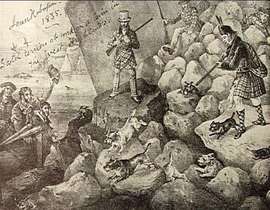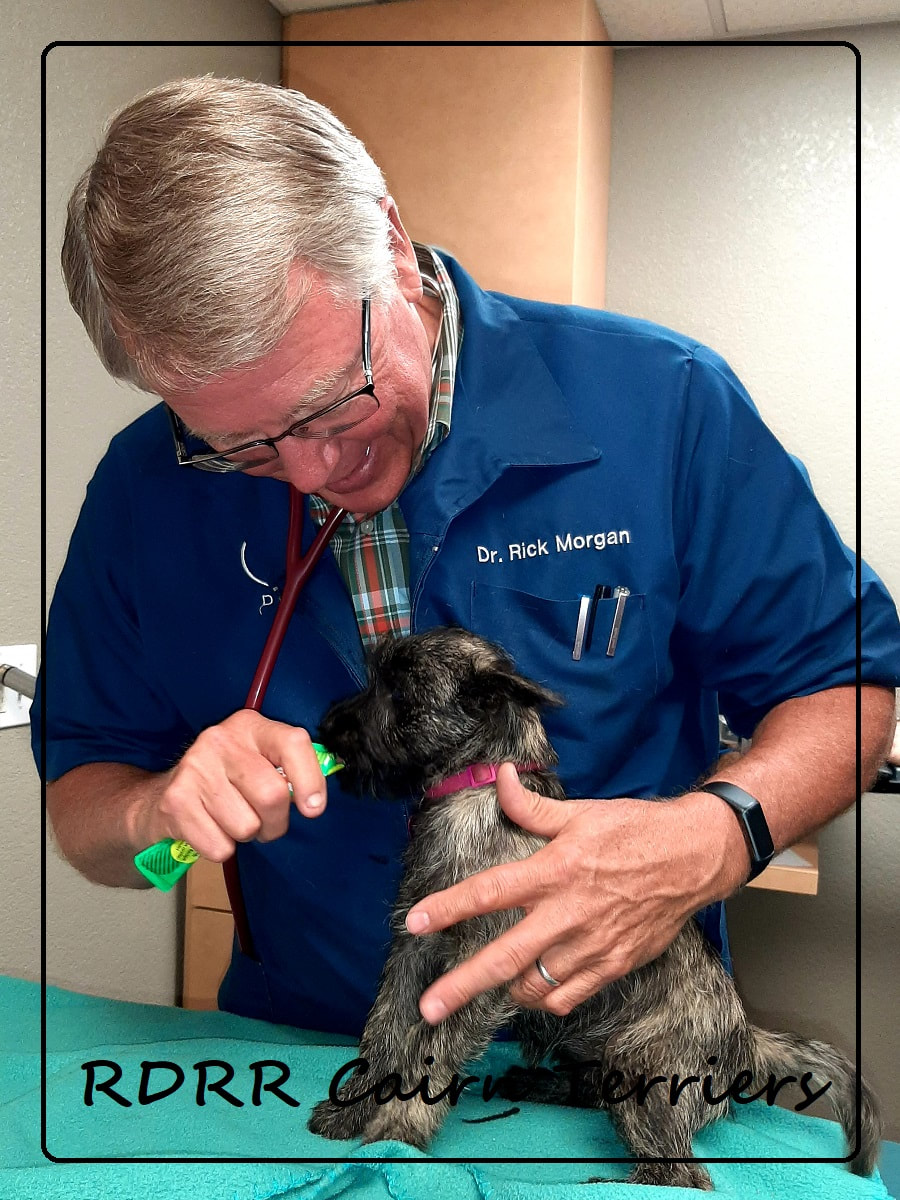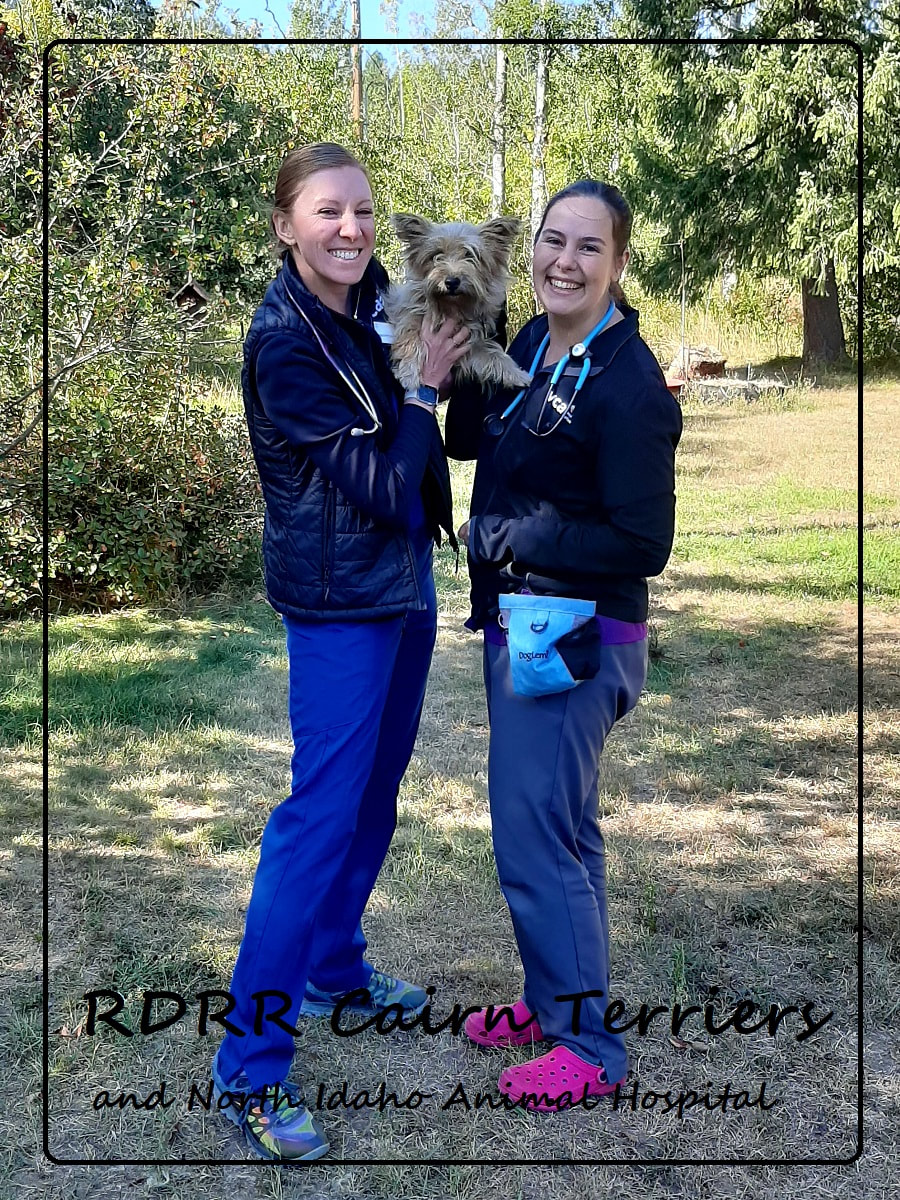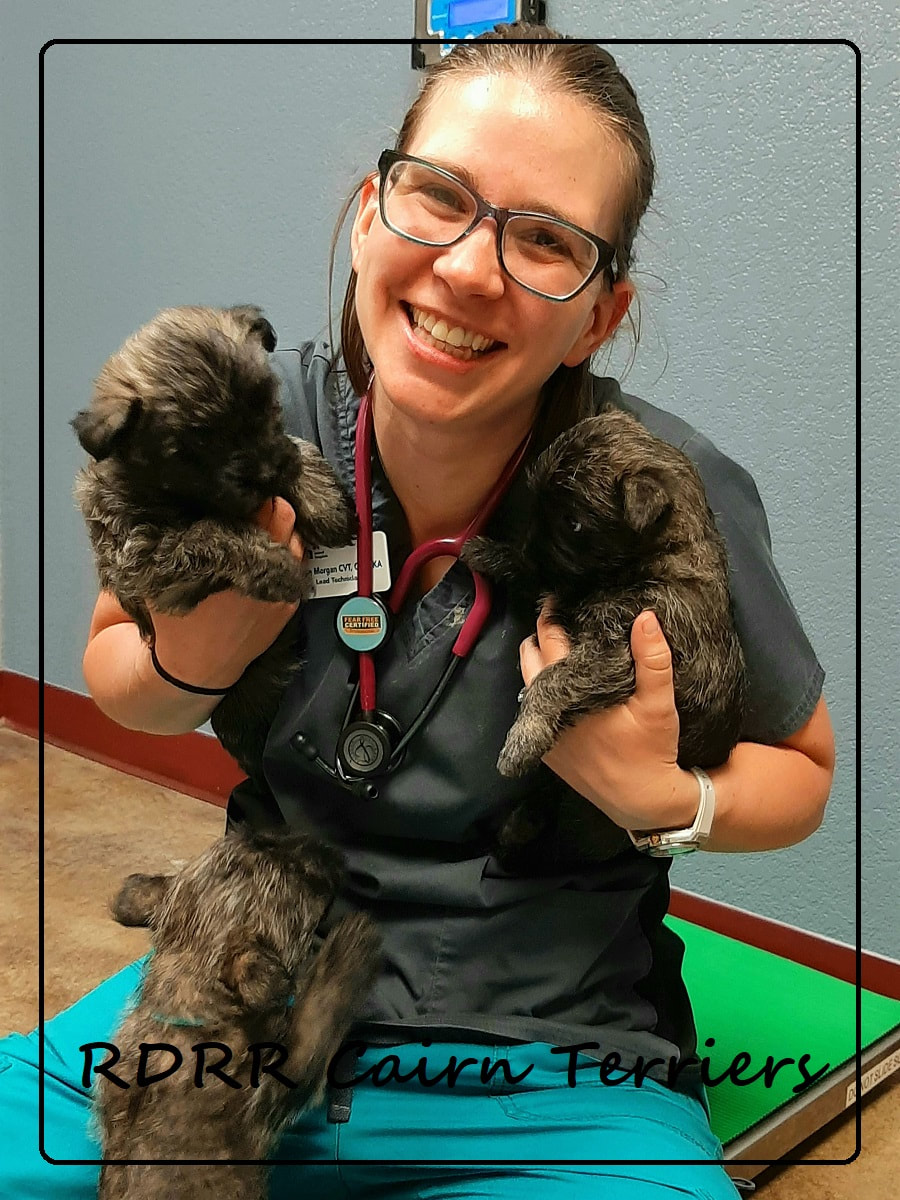
Much of the following information is gleaned (shamelessly pilfered!) from the AKC website, and other informational sites, on Cairn Terriers.
AKC Cairn breed information site is: http://www.akc.org/dog-breeds/cairn-terrier/
History
The Cairn Terrier is one of the oldest of the terrier breeds, originating in the Scottish Highlands and recognized as one of Scotland's earliest working dogs. The word terrier is rooted from the Latin terre, meaning earth, as the dogs will go underground after their prey.
Although the breed had existed long before, the name Cairn Terrier was a compromise suggestion after the breed was originally brought to official shows in the United Kingdom in 1909 under the name Short-haired Skye terriers. This name was not acceptable to the UK Kennel Club due to opposition from Skye Terrier breeders, and the name Cairn Terrier was suggested as an alternative. The name Cairn was chosen because the breed's function was to hunt and chase quarry between the rock cairns in the Scottish highlands. Cairns were initially grouped in the "Skye Terrier" class alongside the Scottish and West Highland White Terriers. In the early 1900s, the three breeds began to be bred separately. They are usually left-pawed, which has been shown in dogs to correlate to superior performance in tasks related to scent. Cairn Terriers are ratters.
Description
The Cairn Terrier has a harsh weather-resistant outer coat that can be pink, blue, wheaten, red, sandy, gray, or brindled in any of these colours. Pure black, black and tan, and white are not permitted by many kennel clubs. While registration of white Cairns was once permitted, after 1917, the American Kennel Club required them to be registered as West Highland White Terriers. A notable characteristic of Cairns is that brindled Cairns frequently change colour throughout their lifetime. It is not uncommon for a brindled Cairn to become progressively more black or silver as it ages. The Cairn is double-coated, with a soft, dense undercoat and a harsh outer coat. A well-groomed Cairn has a rough-and-ready appearance, free of artifice or exaggeration. The Cairn Terrier was registered into the American kennel club in 1903.
Ideal Size: This measurement involves the weight, the height at the withers and the length of body. Weight for females, thirteen pounds; for males, fourteen pounds. Height at the withers, females nine and a half inches; males, ten inches. Length of body from fourteen and a quarter to fifteen inches from the front of the chest to back of hindquarters.
Grooming
Cairn Terriers shed very little but should always be hand stripped. Using scissors or shears can ruin the dog's rugged outer coat after one grooming. Hand stripping involves pulling the old dead hair out by the roots. If done incorrectly this can cause discomfort to the dog, causing it to shy away from future hand stripping. Removing the dead hair in this manner allows new growth to come in. This new growth helps protect the dog from water and dirt.
Cairn Terrier ancestors are from Scotland, where the wire coat repels water and keeps the dog dry even in rainy or damp climates. Keeping the Cairn Terrier coat in its original state will prevent possible skin irritations. As dead hair is removed by stripping the coat, new growth comes in and the skin and coat will remain healthy. Clipper-cutting a Cairn might destroy the protective wire coat unique to this breed.
Frequent bathing can cause the skin to become sensitive and develop rashes and infections. An actual bath should be needed only once or twice a year.
We brush our dogs on a semi-weekly basis with a Mars Coat King Original curry comb. We choose NOT to bath our dogs unless they rolled in something really nasty. Frequent brushing and nail-trimming keep our dogs comfortable, clean, and tidy. Because of their course natural coat, a good brushing removes dirt and debris quite nicely.
Health
These dogs are generally healthy and live on average anywhere from 12 to 17 years.
The AKC and the Cairn Terrier Club of America recommend the following screenings for breeding dogs:
We are pleased and proud to be clients of VCA North Idaho Animal Hospital, located in Sandpoint, Idaho.
Their website is at: Veterinarians in Sandpoint, ID | VCA North Idaho Animal Hospital (vcahospitals.com)
All of our breeding ladies have undergone updated screenings, as of January 2021, and are cleared by Paw Print Genetics for any DNA tested traits.
However, regarding PSVA and MVD: we recommend that every puppy be screened at the age of 16 weeks. While our breeding dogs have been screened and cleared for normal bile acids levels, there is not an accurate DNA screening for liver shunt issues at this time.
Please read the following link:
cairnterrier.org/index.php/Static/liver-portosystemic-vascular-anomaly-psva-and-microvascular-dyplasia-mvd
Preventive Care
We vaccinate puppies at seven weeks, ten weeks, thirteen weeks, and sixteen weeks. After that we routinely vaccinate with a five-way on an annual basis.
Rabies vaccines are administered per our veterinarian protocol, at sixteen weeks, one year, and once every three years after that.
We deworm puppies beginning at two weeks with pyrantel pamoate and switch to fenbendazole at seven weeks. Our adult dogs are dewormed two or three times each year. We alternate the deworming medication to prevent any resistance to treatments.
We use a monthly topical treatment on every adult dog in our home to prevent fleas & ticks. Because we live in an area with lots of warm-weather biting bugs, we use Wondercide products on our dogs in-between treatments, on puppies, and in our home & yards.
We recommend that you work closely with your veterinarian, maintain routine examinations and vaccinations that are necessary for your area.
Disposition
Cairn Terriers are independent little bundles of energy. They are alert and active with the trademark terrier temperament: inquisitive, bossy, feisty, and fearless. They are intelligent and can be a bit mischievous. Warn your flowers -- many Cairns love to dig! Obedience training is very important with this breed. They will try to test your limits, and are born assertive (but not aggressive). They are not usually problem barkers, but will bark if bored or lonely. They love their families and need attention and affection from their humans. They are protective of their families, and will defend their territory with courage and devotion, but they are also people-oriented and are friendly with everyone they meet. They love gentle children but will not tolerate mistreatment from anyone. They need regular exercise, but need to be kept on a leash or in a fenced-in area, as their prey drive is strong and they will chase small animals. They have been known to harass, and sometimes hurt, cats. They generally do well with other dogs, but will stand their ground if challenged. They love long walks and like to play ball, or simply tear around the backyard with the kids. They excel at obedience, agility, and tracking trials. They remain active and playful well into their teen years. They are companionable, loyal and loving. They make great listeners, perky playmates, and good foot warmers. They've been called "the best little pal in the world." And they are always a work in progress.
AKC Cairn breed information site is: http://www.akc.org/dog-breeds/cairn-terrier/
History
The Cairn Terrier is one of the oldest of the terrier breeds, originating in the Scottish Highlands and recognized as one of Scotland's earliest working dogs. The word terrier is rooted from the Latin terre, meaning earth, as the dogs will go underground after their prey.
Although the breed had existed long before, the name Cairn Terrier was a compromise suggestion after the breed was originally brought to official shows in the United Kingdom in 1909 under the name Short-haired Skye terriers. This name was not acceptable to the UK Kennel Club due to opposition from Skye Terrier breeders, and the name Cairn Terrier was suggested as an alternative. The name Cairn was chosen because the breed's function was to hunt and chase quarry between the rock cairns in the Scottish highlands. Cairns were initially grouped in the "Skye Terrier" class alongside the Scottish and West Highland White Terriers. In the early 1900s, the three breeds began to be bred separately. They are usually left-pawed, which has been shown in dogs to correlate to superior performance in tasks related to scent. Cairn Terriers are ratters.
Description
The Cairn Terrier has a harsh weather-resistant outer coat that can be pink, blue, wheaten, red, sandy, gray, or brindled in any of these colours. Pure black, black and tan, and white are not permitted by many kennel clubs. While registration of white Cairns was once permitted, after 1917, the American Kennel Club required them to be registered as West Highland White Terriers. A notable characteristic of Cairns is that brindled Cairns frequently change colour throughout their lifetime. It is not uncommon for a brindled Cairn to become progressively more black or silver as it ages. The Cairn is double-coated, with a soft, dense undercoat and a harsh outer coat. A well-groomed Cairn has a rough-and-ready appearance, free of artifice or exaggeration. The Cairn Terrier was registered into the American kennel club in 1903.
Ideal Size: This measurement involves the weight, the height at the withers and the length of body. Weight for females, thirteen pounds; for males, fourteen pounds. Height at the withers, females nine and a half inches; males, ten inches. Length of body from fourteen and a quarter to fifteen inches from the front of the chest to back of hindquarters.
Grooming
Cairn Terriers shed very little but should always be hand stripped. Using scissors or shears can ruin the dog's rugged outer coat after one grooming. Hand stripping involves pulling the old dead hair out by the roots. If done incorrectly this can cause discomfort to the dog, causing it to shy away from future hand stripping. Removing the dead hair in this manner allows new growth to come in. This new growth helps protect the dog from water and dirt.
Cairn Terrier ancestors are from Scotland, where the wire coat repels water and keeps the dog dry even in rainy or damp climates. Keeping the Cairn Terrier coat in its original state will prevent possible skin irritations. As dead hair is removed by stripping the coat, new growth comes in and the skin and coat will remain healthy. Clipper-cutting a Cairn might destroy the protective wire coat unique to this breed.
Frequent bathing can cause the skin to become sensitive and develop rashes and infections. An actual bath should be needed only once or twice a year.
We brush our dogs on a semi-weekly basis with a Mars Coat King Original curry comb. We choose NOT to bath our dogs unless they rolled in something really nasty. Frequent brushing and nail-trimming keep our dogs comfortable, clean, and tidy. Because of their course natural coat, a good brushing removes dirt and debris quite nicely.
Health
These dogs are generally healthy and live on average anywhere from 12 to 17 years.
The AKC and the Cairn Terrier Club of America recommend the following screenings for breeding dogs:
- Ophthalmologist Evaluation
- Cardiac Exam
- Patella Evaluation
- GCL DNA Test
- PSVA
- MVD
- Kidney Aplasia/Dysplasia
We are pleased and proud to be clients of VCA North Idaho Animal Hospital, located in Sandpoint, Idaho.
Their website is at: Veterinarians in Sandpoint, ID | VCA North Idaho Animal Hospital (vcahospitals.com)
All of our breeding ladies have undergone updated screenings, as of January 2021, and are cleared by Paw Print Genetics for any DNA tested traits.
However, regarding PSVA and MVD: we recommend that every puppy be screened at the age of 16 weeks. While our breeding dogs have been screened and cleared for normal bile acids levels, there is not an accurate DNA screening for liver shunt issues at this time.
Please read the following link:
cairnterrier.org/index.php/Static/liver-portosystemic-vascular-anomaly-psva-and-microvascular-dyplasia-mvd
Preventive Care
We vaccinate puppies at seven weeks, ten weeks, thirteen weeks, and sixteen weeks. After that we routinely vaccinate with a five-way on an annual basis.
Rabies vaccines are administered per our veterinarian protocol, at sixteen weeks, one year, and once every three years after that.
We deworm puppies beginning at two weeks with pyrantel pamoate and switch to fenbendazole at seven weeks. Our adult dogs are dewormed two or three times each year. We alternate the deworming medication to prevent any resistance to treatments.
We use a monthly topical treatment on every adult dog in our home to prevent fleas & ticks. Because we live in an area with lots of warm-weather biting bugs, we use Wondercide products on our dogs in-between treatments, on puppies, and in our home & yards.
We recommend that you work closely with your veterinarian, maintain routine examinations and vaccinations that are necessary for your area.
Disposition
Cairn Terriers are independent little bundles of energy. They are alert and active with the trademark terrier temperament: inquisitive, bossy, feisty, and fearless. They are intelligent and can be a bit mischievous. Warn your flowers -- many Cairns love to dig! Obedience training is very important with this breed. They will try to test your limits, and are born assertive (but not aggressive). They are not usually problem barkers, but will bark if bored or lonely. They love their families and need attention and affection from their humans. They are protective of their families, and will defend their territory with courage and devotion, but they are also people-oriented and are friendly with everyone they meet. They love gentle children but will not tolerate mistreatment from anyone. They need regular exercise, but need to be kept on a leash or in a fenced-in area, as their prey drive is strong and they will chase small animals. They have been known to harass, and sometimes hurt, cats. They generally do well with other dogs, but will stand their ground if challenged. They love long walks and like to play ball, or simply tear around the backyard with the kids. They excel at obedience, agility, and tracking trials. They remain active and playful well into their teen years. They are companionable, loyal and loving. They make great listeners, perky playmates, and good foot warmers. They've been called "the best little pal in the world." And they are always a work in progress.



